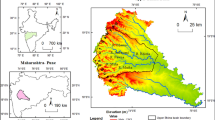Abstract
The soil conservation service (SCS) methodology for computing direct run-off, using soil-cover-moisture complexes involves the selection of a runoff curve number (CN) for such complex events. This method has been further simplified by introducing an assumption on initial abstraction, with only one unknown parameter CN, which is represented by the potential retention capacity of the watershed (S). In this study, coupled SCN-CN with USLE model was used for the estimation of the runoff and sediment yield for eleven watersheds of different land uses (urban, agricultural, and forest) from Damodar Valley Corporation (DVC), Hazaribagh district, Jharkhand, India. For the validation, runoffsediment yield model is employed to a large set of rainfall-runoff-sediment yield data (68 storm events) observed from eleven watersheds. Model performance was assessed by using Nash and Sutcliffe statistical method. The efficiency of results was varying from 60.42 to 92.99 % for sediment yield and 54.23 to 96.12 % for runoff; this efficiency showed a reliable performance of model for estimating the sediment yield and runoff.
Similar content being viewed by others
References
Beasley, D.B., Huggins, L.F. and Monke, E.J. (1980) ANSWERS: a model for watershed planning, Trans. ASAE, v.23, pp.938–94.
Foster, G.R., Meyer, L.D. and Onstad, C.A. (1977) A runoff erosivity factor and variable slope length exponents for soil loss estimates. Trans. ASAE, v.20(4), pp.683–687.
Gao, G. Y., Fu, B. J., Lu, Y. H., Liu, Y., Wang, S. and Zhou, J. (2012) Coupling the modified SCS-CN and RUSLE models to simulate hydrological effects of restoring vegetation in the Loess Plateau of China, Hydrol. Earth Syst. Sci., v.16, pp.2347–2364.
Haan, C.T., Johnson, H.P. and Brakensiek, D.L. (1982) Hydrologic modeling of small watersheds. ASAE Monograph No.5, Amer. Soc. Agricu. Eng., Michigan, 533 p.
Hawkins, R.H. (1993) Asymptotic determination of runoff curve numbers from data. Jour. Irrig. Drainage Engg., v.119(2), pp.334–345.
Kinnell, P.I.A. (2005) Why the universal soil loss equation and the revised version of it do not predict event erosion well. Hydrol. Process., v.19, pp.851–854.
Knisel, W.G. (1980) CREAMS: a field-scale model for chemical, runoff and erosion from agricultural management systems, Conservation Research Report, vol. 26, South East Area, US Department, of Agriculture, Washington, DC.
Leonard, R.A., Knisel, W.G. and Still, D.A. (1987) GLEAMS: groundwater loading effects on agricultural management systems. Trans. ASAE, v.30(5), pp.1403–1428.
Merritt, W.S., Letcher, R.A. and Jakeman, A.J. (2003) A review of erosion and sediment transport models. Environ. Model. Software v.18, pp.761–799.
Mishra, S.K. and Singh, V.P. (2003) Soil Conservation Service Curve Number (SCS-CN) Methodology, Kluwer Academic Publishers, Dordrecht, The Netherlands.
Mishra, S.K. and Singh, V.P. (2003a) Soil Conservation Service Curve Number (SCS-CN) Methodology. Kluwer Academic Publishers, Dordrecht, The Netherlands, ISBN 1-4020-1132-6.
Mishra, S.K., Tyagi, J.V., Singh, V.P. and Singh, Ranvir, (2006) SCS-CN-based modeling of sediment yield, department of water resources Development and management, Indian institute of technology, Roorkee, Uttaranchal, India.
Nash, J.E., and Sutcliffe, J.V. (1970) Soil Conservation Service Curve Number method: how to mend a wrong soil moisture accounting procedure. Water Resour. Res., v.41.
Neitsch, S.L., Arnold, J.G., Kiniry, J.R. and Williams, J.R. (2005) Soil and water assessment tool theoretical documentation, Texas Water Resources Institute, College Station, TX.
Novotny, V. and Olem, H. (1994) Water Quality: Prevention, Identification, and Management of Diffuse Pollution. Wiley, New York.
Ponce, V.M. and Hawkins, R.H. (1996) Runoff curve number: has it reached maturity. Jour. Hydrol. Engg. ASCE, v.1, pp.11–18.
RODE, M. and FREDE, H.G., 1997. Modification of AGNPS for agricultural land and climate conditions central Germany. Jour. Environ. Qual., v.26(1), pp.165–172.
Sarangi, A., Singh, D.K. and Singh, A.K. (2008) Evaluation of curve number and geomorphology-based models for surface runoff prediction from ungauged watersheds. Research Articles. Curr. Sci., v.94(12), pp.1620–1626.
SAS (1988) SAS/STAT User’s Guide, Release 6.03 Edition, Statistical Analysis System Institute Inc., SAS Circle, Box 8000, Cary, NC27512-8000.
SCS (1956) National Engineering Handbook, Hydrology, Section 4, Soil Conservation Service, US Department of Agriculture, Washington DC.
Sharpley, N. and Williams, J.R. (Eds.) (1990) EPIC-Erosion Productivity Impact Calculator: 1. Model Documentation, USDA Tech. Bull. No.1768.
Subramanya, K. (2008) Engineering Hydrology. Tata McGraw Hill, 3rd Edition, pp.155-159.
Tyagi, J.V., Mishra, S.K., Singh and Ranvir, Singh, V.P. (2008) SCS-CN based time-distributed sediment yield model. Jour. Hydrol., v.352, pp.388–403.
Williams, J.R. and Berndt, H.D., 1977. Sediment yield prediction based on watershed hydrology Trans. ASAE, v.20, pp.1100–1104.
Wischmeier, W.H. and Smith, D.D. (1965) Predicting Rainfall-Erosion Losses from Cropland East of Rocky Mountains, USDAAgricultural Handbook, No.282, Washington, DC.
Young, R.A., Onstad, C.A., Bosch, D.D. and Anderson, W.P. (1989) AGNPS: a nonpoint-source pollution model for evaluating agricultural watersheds. Jour. Soil Water Conserv., v.44(2), pp.168–173.
Author information
Authors and Affiliations
Corresponding author
Rights and permissions
About this article
Cite this article
Srivastava, R.K., Imtiyaz, M. Testing of coupled SCS curve number model for estimating runoff and sediment yield for eleven watersheds. J Geol Soc India 88, 627–636 (2016). https://doi.org/10.1007/s12594-016-0529-z
Received:
Accepted:
Published:
Issue Date:
DOI: https://doi.org/10.1007/s12594-016-0529-z




